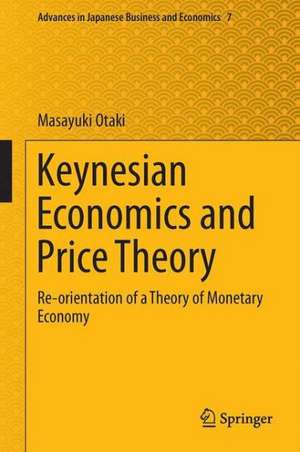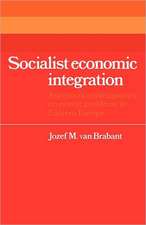Keynesian Economics and Price Theory: Re-orientation of a Theory of Monetary Economy: Advances in Japanese Business and Economics, cartea 7
Autor Masayuki Otakien Limba Engleză Hardback – 6 mar 2015
New Keynesian theory contains logical inconsistencies: menu costs that have no close relationship with microeconomics and MIU, which implies that the money accumulated as wealth is never spent. These two assumptions do not proximate the real world. In this volume, the author discusses how various segregated theoretical approaches in macroeconomics relate to one another and proposes how to integrate them.
| Toate formatele și edițiile | Preț | Express |
|---|---|---|
| Paperback (1) | 383.93 lei 6-8 săpt. | |
| Springer – 9 oct 2016 | 383.93 lei 6-8 săpt. | |
| Hardback (1) | 391.22 lei 6-8 săpt. | |
| Springer – 6 mar 2015 | 391.22 lei 6-8 săpt. |
Din seria Advances in Japanese Business and Economics
- 24%
 Preț: 619.85 lei
Preț: 619.85 lei - 20%
 Preț: 557.71 lei
Preț: 557.71 lei - 24%
 Preț: 789.80 lei
Preț: 789.80 lei - 15%
 Preț: 646.30 lei
Preț: 646.30 lei -
 Preț: 390.63 lei
Preț: 390.63 lei - 18%
 Preț: 736.64 lei
Preț: 736.64 lei - 18%
 Preț: 722.88 lei
Preț: 722.88 lei - 18%
 Preț: 730.16 lei
Preț: 730.16 lei - 15%
 Preț: 644.30 lei
Preț: 644.30 lei - 15%
 Preț: 583.28 lei
Preț: 583.28 lei - 18%
 Preț: 730.65 lei
Preț: 730.65 lei - 18%
 Preț: 785.11 lei
Preț: 785.11 lei - 18%
 Preț: 731.10 lei
Preț: 731.10 lei - 15%
 Preț: 647.27 lei
Preț: 647.27 lei -
 Preț: 389.31 lei
Preț: 389.31 lei - 18%
 Preț: 887.86 lei
Preț: 887.86 lei - 24%
 Preț: 599.84 lei
Preț: 599.84 lei - 15%
 Preț: 526.83 lei
Preț: 526.83 lei - 18%
 Preț: 784.30 lei
Preț: 784.30 lei -
 Preț: 389.70 lei
Preț: 389.70 lei - 18%
 Preț: 723.56 lei
Preț: 723.56 lei - 18%
 Preț: 999.60 lei
Preț: 999.60 lei - 18%
 Preț: 724.80 lei
Preț: 724.80 lei - 18%
 Preț: 724.00 lei
Preț: 724.00 lei - 18%
 Preț: 949.10 lei
Preț: 949.10 lei - 18%
 Preț: 780.52 lei
Preț: 780.52 lei - 18%
 Preț: 784.13 lei
Preț: 784.13 lei -
 Preț: 394.29 lei
Preț: 394.29 lei - 15%
 Preț: 642.18 lei
Preț: 642.18 lei - 15%
 Preț: 649.22 lei
Preț: 649.22 lei -
 Preț: 390.63 lei
Preț: 390.63 lei - 27%
 Preț: 517.86 lei
Preț: 517.86 lei
Preț: 391.22 lei
Nou
Puncte Express: 587
Preț estimativ în valută:
74.86€ • 78.17$ • 61.82£
74.86€ • 78.17$ • 61.82£
Carte tipărită la comandă
Livrare economică 16-30 aprilie
Preluare comenzi: 021 569.72.76
Specificații
ISBN-13: 9784431553441
ISBN-10: 4431553444
Pagini: 207
Ilustrații: XV, 207 p. 22 illus., 1 illus. in color.
Dimensiuni: 155 x 235 x 20 mm
Greutate: 0.49 kg
Ediția:2015
Editura: Springer
Colecția Springer
Seria Advances in Japanese Business and Economics
Locul publicării:Tokyo, Japan
ISBN-10: 4431553444
Pagini: 207
Ilustrații: XV, 207 p. 22 illus., 1 illus. in color.
Dimensiuni: 155 x 235 x 20 mm
Greutate: 0.49 kg
Ediția:2015
Editura: Springer
Colecția Springer
Seria Advances in Japanese Business and Economics
Locul publicării:Tokyo, Japan
Public țintă
ResearchCuprins
Chapter 1 Introduction.- Part 1 Keynesian Economics and Price Theory.- Chapter 2 Price Theory in a Monetary Economy.- Part 2 Applications to Labor Economics and Inflation Theory.- Chapter 3 The Existence of an Involuntary Unemployment Equilibrium.- Chapter 4 The Phillips Curve and Inflation Theory Reconsidered.- Part 3 Applications to International Economics.- Chapter 5 A Basic Model of a Flexible Exchange Rate System under Perfect Capital Mobility.- Chapter 6 The Functions of a Key Currency: International Liquidity Provision and Insurance.- Chapter 7 On the Necessity of Optimum Currency Areas: The Case for Perfect Capital Mobility and Immobile Labor Forces.- Chapter 8 Universal Discipline or Individual Discipline: On the Viability of the Eurozone as a Nonadjustable Local Fixed Exchange Rate Regime.- Chapter 9 Industrial Hollowing Under a Flexible Exchange Rate System .- Chapter 10 On the Function of Gold Standard in Idealism and Reality.- Part 4 Applications to Economic Growth Theory.- Chapter 11 Dexterity as a Source of Economic Growth.- Chapter 12 Monetary Economic Growth Theory under Perfect Competition: Can Monetary Expansion Really Enhance Economic Growth?.- Chapter 13 A Keynesian Monetary Growth Model under Monopolistic Competition: Is Economic Growth Sustainable without Government Help?.- Part 5 Critiques of the Existing Monetary Theories.- Chapter 14 A Critique of Lucas' Theory.- Chapter 15 Does the Search Model Succeed in Describing a Monetary Economy?.
Textul de pe ultima copertă
This book reconstructs Keynesian macroeconomics so that it is compatible with the neoclassical dynamic microeconomic theory. This theory adopts three postulates: rational expectations, perfect price flexibility, and exclusion of the money in utility function (MIU). Based on the new theoretical finding that the Lucas model (1972) contains multiple equilibria, the author unifies Keynesian and monetarist theories within the same framework. The book applies the above basic theory to international macroeconomics and economic growth theory.
New Keynesian theory contains logical inconsistencies: menu costs that have no close relationship with microeconomics and MIU, which implies that the money accumulated as wealth is never spent. These two assumptions do not proximate the real world. In this volume, the author discusses how various segregated theoretical approaches in macroeconomics relate to one another and proposes how to integrate them.
New Keynesian theory contains logical inconsistencies: menu costs that have no close relationship with microeconomics and MIU, which implies that the money accumulated as wealth is never spent. These two assumptions do not proximate the real world. In this volume, the author discusses how various segregated theoretical approaches in macroeconomics relate to one another and proposes how to integrate them.
Caracteristici
Effective demand and involuntary unemployment theory, compatible with neoclassical dynamic microeconomics, excluding ad-hoc price stickiness and money in utility assumptions Rigorous dynamic microeconomics foundation for Keynesian international monetary theory and monetary growth theory Fundamental critiques on existing new Keynesian theory and Lucas’ monetarist theory Includes supplementary material: sn.pub/extras















